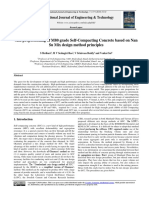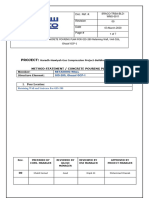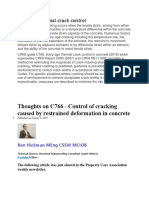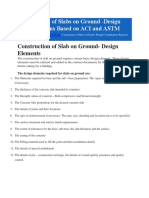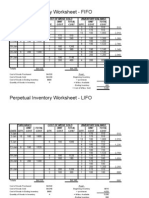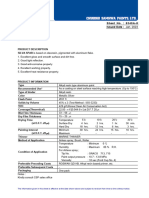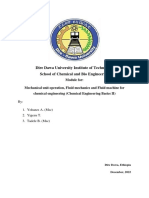0 ratings0% found this document useful (0 votes)
93 viewsUltrasonic Testing of Concrete
Ultrasonic Testing of Concrete
Uploaded by
AshrafUltrasonic pulse velocity (UPV) testing is an effective non-destructive testing method for assessing concrete quality by measuring how fast ultrasonic waves travel through the material. UPV testing works by transmitting ultrasonic waves through concrete and measuring the travel time, with higher travel times indicating lower quality or defects. The test can be used to evaluate concrete uniformity, estimate crack depths, and predict compressive strength. Proper transducer contact with couplant and accounting for factors like rebar and test configuration are important for reliable UPV test results.
Copyright:
© All Rights Reserved
Available Formats
Download as DOCX, PDF, TXT or read online from Scribd
Ultrasonic Testing of Concrete
Ultrasonic Testing of Concrete
Uploaded by
Ashraf0 ratings0% found this document useful (0 votes)
93 views4 pagesUltrasonic pulse velocity (UPV) testing is an effective non-destructive testing method for assessing concrete quality by measuring how fast ultrasonic waves travel through the material. UPV testing works by transmitting ultrasonic waves through concrete and measuring the travel time, with higher travel times indicating lower quality or defects. The test can be used to evaluate concrete uniformity, estimate crack depths, and predict compressive strength. Proper transducer contact with couplant and accounting for factors like rebar and test configuration are important for reliable UPV test results.
Original Description:
test
Copyright
© © All Rights Reserved
Available Formats
DOCX, PDF, TXT or read online from Scribd
Share this document
Did you find this document useful?
Is this content inappropriate?
Ultrasonic pulse velocity (UPV) testing is an effective non-destructive testing method for assessing concrete quality by measuring how fast ultrasonic waves travel through the material. UPV testing works by transmitting ultrasonic waves through concrete and measuring the travel time, with higher travel times indicating lower quality or defects. The test can be used to evaluate concrete uniformity, estimate crack depths, and predict compressive strength. Proper transducer contact with couplant and accounting for factors like rebar and test configuration are important for reliable UPV test results.
Copyright:
© All Rights Reserved
Available Formats
Download as DOCX, PDF, TXT or read online from Scribd
Download as docx, pdf, or txt
0 ratings0% found this document useful (0 votes)
93 views4 pagesUltrasonic Testing of Concrete
Ultrasonic Testing of Concrete
Uploaded by
AshrafUltrasonic pulse velocity (UPV) testing is an effective non-destructive testing method for assessing concrete quality by measuring how fast ultrasonic waves travel through the material. UPV testing works by transmitting ultrasonic waves through concrete and measuring the travel time, with higher travel times indicating lower quality or defects. The test can be used to evaluate concrete uniformity, estimate crack depths, and predict compressive strength. Proper transducer contact with couplant and accounting for factors like rebar and test configuration are important for reliable UPV test results.
Copyright:
© All Rights Reserved
Available Formats
Download as DOCX, PDF, TXT or read online from Scribd
Download as docx, pdf, or txt
You are on page 1of 4
Ultrasonic Testing of Concrete
Posted on April 13, 2017
Ultrasonic Pulse Velocity (UPV) is an effective non-destructive testing (NDT) method for
quality control of concrete materials, and detecting damages in structural components.
The UPV methods have traditionally been used for the quality control of materials, mostly
homogeneous materials such as metals and welded connections. With the recent
advancement in transducer technology, the test has been widely accepted in testing
concrete materials. Ultrasonic testing of concrete is an effective way for quality
assessment and uniformity, and crack depth estimation. The test procedure has been
standardized as “Standard Test Method for Pulse Velocity through Concrete” (ASTM C
597, 2016).
Ultrasonic Testing of Concrete - How it works?
The concept behind the technology is measuring the travel time of acoustic waves in a
medium, and correlating them to the elastic properties and density of the material. Travel
time of ultrasonic waves reflects internal condition of test area. In general, for a given
trajectory, higher travel time is correlated to low quality concrete with more anomalies and
deficiencies, while lower travel time is correlated to high quality concrete with fewer
anomalies. Once ultrasonic wave spreads within the test area, the wave is reflected in
boundary of anomalies resulting in higher travel time. This results in higher transmission
time (lower wave speeds) in poor quality concrete and lower transmission time (higher
wave speed) in good quality concrete.
Different configurations of transducers can be used to perform
a UPV test. This includes direct transmission, semi-direct transmission, and indirect
(surface) transmission. Figure above shows different configurations of transducer based
on the access to the surface of test area. The ultrasonic velocity is prone to signal travel
trajectory that is defined by the transducer configurations. Figure below is a
representation of the effect of concrete anomalies and deficiencies on the acoustic wave
travel time and the corresponding velocity throughout a given trajectory (ACI 228.2R,
2013).
Couplant | Concrete-Transducer contact
The UPV transducers must be in full contact with the concrete surface; otherwise the air
pocket between the transducer and concrete may result in measurement error (i.e.
inacurate measurement of transit time). One reason is that only negligible amount of wave
energy will be transmitted in a poor contact. Different couplants can be used to eliminate
air pockets and to assure good contact (e.g. petroleum jelly, grease, liquid soap, and
kaolin-glycerol paste). It is recommended to make the couplant layer as thin as possible.
Applications of UPV Testing for Concrete
Several researchers and engineers have studied the use of ultrasonic testing of
concrete in different engineering projects:
1- Pulse Velocity Determination
2- Concrete Quality Assessment (learn more)
3- Establishing Homogenity and Uniformity of Concrete
4- Measurement of Surface Crack Depth (read more)
5- Prediction of Compressive Strength of Concrete (read more)
UPV - Influencing Parameters
In order to conduct a reliable ultrasonic testing of concrete, the surface of concrete should
be clean, and free of dust. A suitable couplant is needed to establish an ideal connection
between concrete and UPV transducers. Special attention should be given to rebar in
concrete, since the wave travel speed in metal is much higher than in concrete. The
interpretation of test results in heavily reinforced concrete is somewhat difficult. The direct
configuration is the most ideal for getting reliable readings; however, the use of this
configuration is mainly limited to laboratory. In summary, the following issues should be
addressed before, during, and after performing the test:
1- Concrete Properties (aggregate size, type, and content)
2- Transducer Contact/couplant material
3- Presence of Rebar
4- Sensor Configuration
You might also like
- Aci 437.2M-13Document3 pagesAci 437.2M-13Hussein ElsanadedyNo ratings yet
- Crane, Hart - The BridgeDocument73 pagesCrane, Hart - The Bridgecsy7aa100% (2)
- Concrete Quality Technical ManagerDocument2 pagesConcrete Quality Technical ManagerNaveed Shaheen0% (1)
- When No One Is WatchingDocument20 pagesWhen No One Is WatchingSara AnyNo ratings yet
- Salvation UnlimitedDocument132 pagesSalvation UnlimitedlewildaleNo ratings yet
- Soils I Study GuideDocument7 pagesSoils I Study GuideYu Tan0% (1)
- Ytl Cement - Kursb 1Document1 pageYtl Cement - Kursb 1الهادي الياس100% (1)
- Inspector (Highways and Sewers): Passbooks Study GuideFrom EverandInspector (Highways and Sewers): Passbooks Study GuideNo ratings yet
- Dictionar Frazeologic Englez RomanDocument302 pagesDictionar Frazeologic Englez RomanJaaljNo ratings yet
- M o S For Grouting-01Document6 pagesM o S For Grouting-01civil.godfatherNo ratings yet
- Defects in Plaster & RemediesDocument3 pagesDefects in Plaster & RemediesGaurav DhumneNo ratings yet
- TMS 302 Sound Standard Public Comment Version 2018-08-07Document19 pagesTMS 302 Sound Standard Public Comment Version 2018-08-07gare1404No ratings yet
- Astm D 3282 - 93 - R 2004Document6 pagesAstm D 3282 - 93 - R 2004anish_am2005No ratings yet
- Guidelines FOR Special Inspection IN Construction: C C T I ADocument43 pagesGuidelines FOR Special Inspection IN Construction: C C T I AMikhael Ayoub MikhaelNo ratings yet
- SERIES 7000: Tolerances, Testing and Quality ControlDocument28 pagesSERIES 7000: Tolerances, Testing and Quality ControlM.GargoumNo ratings yet
- ACI JTA Concrete Strength Technician PDFDocument3 pagesACI JTA Concrete Strength Technician PDFjerin sam kurianNo ratings yet
- Chapter 9: Evalua On and Acceptance of Hardened ConcreteDocument9 pagesChapter 9: Evalua On and Acceptance of Hardened ConcreteGaneshNo ratings yet
- Quality Control Engineer Interview Question 1Document7 pagesQuality Control Engineer Interview Question 1c2q65xy2yqNo ratings yet
- Aci 301-20Document3 pagesAci 301-20Noaman Rehan50% (2)
- 03 30 00 Cast in Place Concrete ChristensonDocument9 pages03 30 00 Cast in Place Concrete ChristensonHendra Rikardo TobingNo ratings yet
- IS 4031 - Part10Document5 pagesIS 4031 - Part10SourabhAdikeNo ratings yet
- SEAoNY-concrete Testing 022410Document55 pagesSEAoNY-concrete Testing 022410Raghuveer ShenoyNo ratings yet
- Fusion Bonded Epoxy Coated Reinforcing Bars - Specification: Indian StandardDocument12 pagesFusion Bonded Epoxy Coated Reinforcing Bars - Specification: Indian StandardsssmouNo ratings yet
- Cement Stabilised SandDocument2 pagesCement Stabilised Sanddrefdref100% (1)
- Renderoc TgxtraDocument2 pagesRenderoc TgxtratalatzahoorNo ratings yet
- DCPT TestDocument10 pagesDCPT TestMonirul Islam BadalNo ratings yet
- DMS-4510, Mechanical CouplersDocument3 pagesDMS-4510, Mechanical CouplersZen NormalNo ratings yet
- 01-Battery Room Ceramic Floor TilesDocument1 page01-Battery Room Ceramic Floor TilesJoey RomeroNo ratings yet
- Ultrasonic Pulse Velocity Test Report: ProjectDocument7 pagesUltrasonic Pulse Velocity Test Report: ProjectChandrashekhar SinghNo ratings yet
- Sealbond ETL 100 Epoxy Tank LiningDocument2 pagesSealbond ETL 100 Epoxy Tank LiningRzeus Adigue100% (1)
- Cast in Place ConcreteDocument62 pagesCast in Place ConcreteTaher AmmarNo ratings yet
- Grading AggregatesDocument1 pageGrading AggregatesIsaiahogedaNo ratings yet
- Early Cracking of Concrete PavementDocument25 pagesEarly Cracking of Concrete PavementRajesh KhadkaNo ratings yet
- Masteremaco S 488: Structural Repair MortarDocument3 pagesMasteremaco S 488: Structural Repair MortarKhan ShahzebNo ratings yet
- C685C685M 14Document9 pagesC685C685M 14Alvin BaraNo ratings yet
- Quality Control ProcessDocument1 pageQuality Control ProcessInayathulla ShareefNo ratings yet
- Hot Weather ConcretingDocument10 pagesHot Weather ConcretingIm ChinithNo ratings yet
- BS 812 102-1989Document16 pagesBS 812 102-1989Alexander WhittakerNo ratings yet
- Astm e 774Document4 pagesAstm e 774Zahoor Ahmed MohsanNo ratings yet
- Effect of Restraint, Volume Change, and Reinforcement On Cracking of Mass ConcreteDocument26 pagesEffect of Restraint, Volume Change, and Reinforcement On Cracking of Mass ConcreteDIDIER ANGEL LOPEZ RINCONNo ratings yet
- Quality Circles in Which Groups of Workers Meet Regularly To Make Suggestions ForDocument11 pagesQuality Circles in Which Groups of Workers Meet Regularly To Make Suggestions Forghenoel26No ratings yet
- Mix Proportioning of M80 Grade Self-Compacting ConDocument3 pagesMix Proportioning of M80 Grade Self-Compacting ConfaseehNo ratings yet
- Material Submittal For Al Sarh Trading & Cont. (C20 &C25 Screed) PDFDocument117 pagesMaterial Submittal For Al Sarh Trading & Cont. (C20 &C25 Screed) PDFBikasNo ratings yet
- BS 12-1989Document8 pagesBS 12-1989U Thaung Myint100% (1)
- ACI 311.5R-97 Guide For Concrete Plant Inspection and Field Testing of Ready-Mixed ConcreteDocument5 pagesACI 311.5R-97 Guide For Concrete Plant Inspection and Field Testing of Ready-Mixed ConcretenathanNo ratings yet
- Concrete TestDocument19 pagesConcrete Testmohammad hafodyNo ratings yet
- Quality Control of Ready Mixed ConcreteDocument7 pagesQuality Control of Ready Mixed ConcreteIOSRjournalNo ratings yet
- ASTM C94-21 Standard Specification For Ready Mix ConcreteDocument7 pagesASTM C94-21 Standard Specification For Ready Mix Concreteryann mananquilNo ratings yet
- Pre-Stressed ConcreteDocument23 pagesPre-Stressed ConcreteShabbar Abbas MalikNo ratings yet
- Section 035440 - Cement-Based ScreedDocument11 pagesSection 035440 - Cement-Based ScreedWENDING HUNo ratings yet
- Setting Time of ConcreteDocument2 pagesSetting Time of ConcretevempadareddyNo ratings yet
- Astm d1633 17 PDFDocument4 pagesAstm d1633 17 PDFAbel CameoNo ratings yet
- Materials Laboratory ManualDocument120 pagesMaterials Laboratory ManualDjole ProleceNo ratings yet
- Portland Cement Plaster Over CMUDocument2 pagesPortland Cement Plaster Over CMUoikono_klast100% (1)
- Density, Absorption, and Voids in Hardened Concrete: Standard Test Method ForDocument3 pagesDensity, Absorption, and Voids in Hardened Concrete: Standard Test Method ForMohamed BelmokaddemNo ratings yet
- Strength Od In-Place ConcreteDocument2 pagesStrength Od In-Place ConcreteaaNo ratings yet
- ACI 207.2 (R2002) EffectofRestraint VolumeChange &reinf Cracking MassConcreteDocument26 pagesACI 207.2 (R2002) EffectofRestraint VolumeChange &reinf Cracking MassConcretephilipyapNo ratings yet
- ASTM C231 Type A - ChecklistDocument4 pagesASTM C231 Type A - ChecklistTienNo ratings yet
- Compressive Strength Test On Concrete CoreDocument4 pagesCompressive Strength Test On Concrete CoreSyed Mohd MehdiNo ratings yet
- Presentation of RTT SitesDocument23 pagesPresentation of RTT Sitestheway2pawan100% (1)
- Concrete Mix DesignDocument17 pagesConcrete Mix DesignSilver Olguín CamachoNo ratings yet
- QM-R83-PL-4039 Procedure For Excavation Backfilling and Compaction Rev. 00Document16 pagesQM-R83-PL-4039 Procedure For Excavation Backfilling and Compaction Rev. 00GaneshNo ratings yet
- Concrete Pouring Plan - GIS-280 Retaining WallDocument9 pagesConcrete Pouring Plan - GIS-280 Retaining WallAdnan ArshidNo ratings yet
- Non Destructive Testing of ConcreteDocument11 pagesNon Destructive Testing of ConcretepraveenNo ratings yet
- Early CracksDocument3 pagesEarly CracksAshraf100% (1)
- Testing of Concrete Cores For StrengthDocument3 pagesTesting of Concrete Cores For StrengthAshraf50% (2)
- Damp Proof CourseDocument7 pagesDamp Proof CourseAshrafNo ratings yet
- Damp Proof Course (DPC) - Methods of DPC Installation in ConstructionDocument7 pagesDamp Proof Course (DPC) - Methods of DPC Installation in ConstructionAshrafNo ratings yet
- Construction of Slabs On GroundDocument7 pagesConstruction of Slabs On GroundAshrafNo ratings yet
- Early Thermal Cracking in Concrete ExplainedDocument5 pagesEarly Thermal Cracking in Concrete ExplainedAshrafNo ratings yet
- Critical Chloride Content in Reinforced ConcreteDocument7 pagesCritical Chloride Content in Reinforced ConcreteAshrafNo ratings yet
- Differences Between Mortar and GroutDocument3 pagesDifferences Between Mortar and GroutAshrafNo ratings yet
- What Is The Difference Between UBCDocument2 pagesWhat Is The Difference Between UBCAshrafNo ratings yet
- Carbonation Chloride Penetration of Concrete StructuresDocument4 pagesCarbonation Chloride Penetration of Concrete StructuresAshrafNo ratings yet
- Use of Bolted Steel Plates For Strengthening of Reinforced Concrete Beams and ColumnsDocument15 pagesUse of Bolted Steel Plates For Strengthening of Reinforced Concrete Beams and ColumnsAshrafNo ratings yet
- CRC 42Document43 pagesCRC 42AshrafNo ratings yet
- Moon FaceDocument8 pagesMoon Facecinta kasihNo ratings yet
- Consumer Credit and Over-Indebtedness in China: Huifen YinDocument19 pagesConsumer Credit and Over-Indebtedness in China: Huifen YinFadel MuhammadNo ratings yet
- Study On The Effectivness of MRF TraingDocument25 pagesStudy On The Effectivness of MRF TraingSreelakshmi Sreekumar100% (2)
- Semester 1 Study GuideDocument6 pagesSemester 1 Study Guideapi-470794148100% (1)
- Module 7 - StramaDocument8 pagesModule 7 - StramaJN CNo ratings yet
- Katie Janness' Mother Releases Heartbreaking LetterDocument1 pageKatie Janness' Mother Releases Heartbreaking LetterAlex JonesNo ratings yet
- Panagat Sa BayDocument6 pagesPanagat Sa BayMary Ann GaldoNo ratings yet
- CaringDocument23 pagesCaringRania omoush100% (1)
- ELA10 (S) Death Customs Oral Presentation - Mia MDocument8 pagesELA10 (S) Death Customs Oral Presentation - Mia MMia EmillaNo ratings yet
- Optical Fiber Splicing ITU-T Recommendation L.400: Jun Carbonell, PECEDocument81 pagesOptical Fiber Splicing ITU-T Recommendation L.400: Jun Carbonell, PECERoss Sonny CruzNo ratings yet
- Virtual RealityDocument204 pagesVirtual RealityAastha TimalsinaNo ratings yet
- Göbekli Tepe - The Stone Age Sanctuaries. New Results of Ongoing Excavations With A Special Focus On Sculptures and High ReliefsDocument18 pagesGöbekli Tepe - The Stone Age Sanctuaries. New Results of Ongoing Excavations With A Special Focus On Sculptures and High Reliefsfrancisco.fazenda.fernandesNo ratings yet
- Pantalla Anterior Bienvenido: Cr080vbesDocument3 pagesPantalla Anterior Bienvenido: Cr080vbesJuan Pablo Virreyra TriguerosNo ratings yet
- (Cambridge Studies in Society and The Life Sciences) Celia Roberts-Messengers of Sex - Hormones, Biomedicine and Feminism-Cambridge University Press (2007)Document249 pages(Cambridge Studies in Society and The Life Sciences) Celia Roberts-Messengers of Sex - Hormones, Biomedicine and Feminism-Cambridge University Press (2007)Rickey ReedNo ratings yet
- Volumetric AnalysisDocument7 pagesVolumetric AnalysisHarshith ChNo ratings yet
- Win-Qa-105 (Lab Quality System)Document1 pageWin-Qa-105 (Lab Quality System)suchig84537No ratings yet
- AAS Level 1 - B1U1 - Lesson PlanDocument16 pagesAAS Level 1 - B1U1 - Lesson PlanTuân DucNo ratings yet
- Perpetual Inventory ExampleDocument3 pagesPerpetual Inventory ExampleSteven Sanderson100% (5)
- 8340a Silva Spar (2301)Document2 pages8340a Silva Spar (2301)4canNo ratings yet
- Fundamentals of Organic ChemistryDocument131 pagesFundamentals of Organic ChemistryApoorv Sharma100% (1)
- bbc-9 1Document8 pagesbbc-9 1kosmc123No ratings yet
- Dire Dawa University Institute of Technology School of Chemical and Bio EngineeringDocument266 pagesDire Dawa University Institute of Technology School of Chemical and Bio EngineeringEcy YghiNo ratings yet
- Districts Training Schedule YUVADocument21 pagesDistricts Training Schedule YUVAsanamsudan8808No ratings yet
- Memo Writing: Turney's TipsDocument2 pagesMemo Writing: Turney's TipskfctcoNo ratings yet
- OB CellLife Final AssignmentDocument22 pagesOB CellLife Final AssignmentTan CSNo ratings yet
- HV7802 14068Document6 pagesHV7802 14068Djzedamendoa Jose LopesNo ratings yet









































